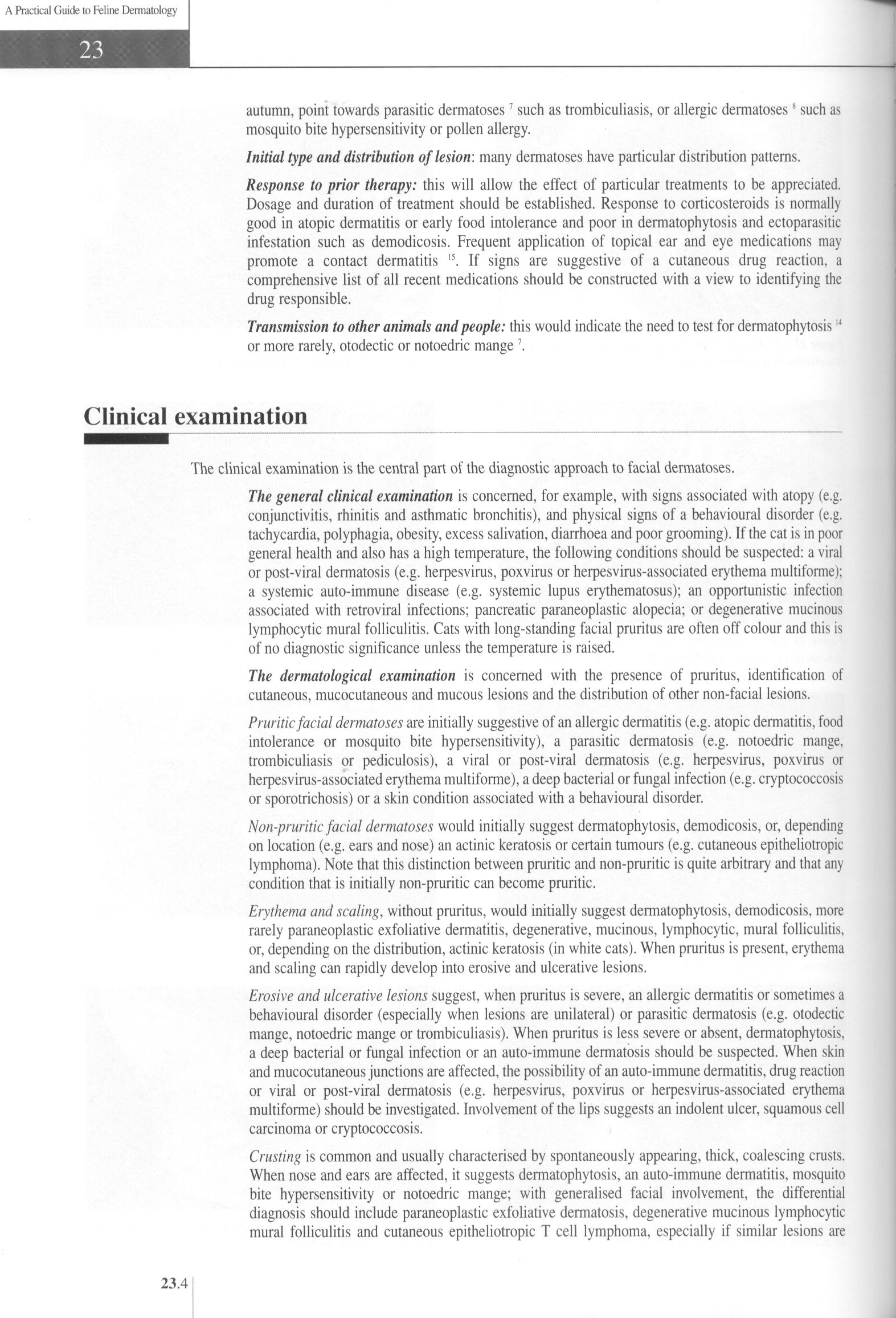234 (22)

23
A Practical Guide to Feline Dermatology
autumn, point towards parasitic dermatoses7 such as trombiculiasis, or allergic dermatoses8 such as mosąuito bite hypersensitivity or pollen allergy.
Initial type and distribution oflesion: many dermatoses have particular distribution pattems.
Response to prior therapy: this will allow the effect of particular treatments to be appreciated. Dosage and duration of treatment should be established. Response to corticosteroids is normally good in atopic dermatitis or early food intolerance and poor in dermatophytosis and ectoparasitic infestation such as demodicosis. Freąuent application of topical ear and eye medications may promote a contact dermatitis 15. If signs are suggestive of a cutaneous drug reaction, a comprehensive list of all recent medications should be constructed with a view to identifying the drug responsible.
Transmission to other animals and people: this would indicate the need to test for dermatophytosis14 or morę rarely, otodectic or notoedric mange \
Clinical examination
The clinical examination is the central part of the diagnostic approach to facial dermatoses.
The generał clinical examination is concemed, for example, with signs associated with atopy (e.g. conjunctivitis, rhinitis and asthmatic bronchitis), and physical signs of a behavioural disorder (e.g. tachycardia, polyphagia, obesity, excess salivation, diarrhoea and poor grooming). If the cat is in poor generał health and also has a high temperaturę, the following conditions should be suspected: a viral or post-viral dermatosis (e.g. herpesvirus, poxvirus or herpesvirus-associated erythema multiforme); a systemie auto-immune disease (e.g. systemie lupus erythematosus); an opportunistic infection associated with retroviral infections; panereatie paraneoplastic alopecia; or degenerative mucinous lymphocytic mural folliculitis. Cats with long-standing facial pruritus are often off colour and this is of no diagnostic significance unless the temperaturę is raised.
The dermatological examination is concemed with the presence of pruritus, identification of cutaneous, mucocutaneous and mucous lesions and the distribution of other non-facial lesions.
Pruritic facial dermatoses are initially suggestive of an allergic dermatitis (e.g. atopic dermatitis, food intolerance or mosąuito bite hypersensitivity), a parasitic dermatosis (e.g. notoedric mange, trombiculiasis or pediculosis), a viral or post-viral dermatosis (e.g. herpesvirus, poxvirus or herpesvirus-associated erythema multiforme), a deep bacterial or fungal infection (e.g. cryptococcosis or sporotrichosis) or a skin condition associated with a behavioural disorder.
Non-pruritic facial dermatoses would initially suggest dermatophytosis, demodicosis, or, depending on location (e.g. ears and nose) an actinic keratosis or certain tumours (e.g. cutaneous epitheliotropic lymphoma). Notę that this distinction between pruritic and non-pruritic is ąuite arbitrary and that any condition that is initially non-pruritic can become pruritic.
Erythema and scaling, without pruritus, would initially suggest dermatophytosis, demodicosis, morę rarely paraneoplastic exfoliative dermatitis, degenerative, mucinous, lymphocytic, mural folliculitis, or, depending on the distribution, actinic keratosis (in white cats). When pruritus is present, erythema and scaling can rapidly develop into erosive and ulcerative lesions.
Erosive and ulcerative lesions suggest, when pruritus is severe, an allergic dermatitis or sometimes a behavioural disorder (especially when lesions are unilateral) or parasitic dermatosis (e.g. otodectic mange, notoedric mange or trombiculiasis). When pruritus is less severe or absent, dermatophytosis, a deep bacterial or fungal infection or an auto-immune dermatosis should be suspected. When skin and mucocutaneous junctions are affected, the possibility of an auto-immune dermatitis, drug reaction or viral or post-viral dermatosis (e.g. herpesvirus, poxvirus or herpesvirus-associated erythema multiforme) should be investigated. Involvement of the lips suggests an indolent uleer, sąuamous celi carcinoma or cryptococcosis.
Crusting is common and usually characterised by spontaneously appearing, thick, coalescing crusts. When nose and ears are affected, it suggests dermatophytosis, an auto-immune dermatitis, mosąuito bite hypersensitivity or notoedric mange; with generalised facial involvement, the differential diagnosis should include paraneoplastic exfoliative dermatosis, degenerative mucinous lymphocytic mural folliculitis and cutaneous epitheliotropic T celi lymphoma, especially if similar lesions are
23.4
Wyszukiwarka
Podobne podstrony:
22 (503) A Practical Guide to Feline Dermatology ■ 2 Table 2:1: Breed predispositions to common d
232 (24) 23 A Practical Guide to Feline Dermatology Table 23 : 1 : Aetiology of facial dermatosesINF
248 (22) 24 A Practical Guide to Feline DermatologyDiagnostic tests Given the incidence of dermatoph
222 (33) 22 A Practical Guide to Feline Dermatology AnimaTs way of life and environment: cats that l
236 (22) Practical Guide to Feline Dermatology23 observed on the whole body. Nodular lesions primari
58 (148) 5 A Practical Guide to Feline Dermatology severity of the illness. High titres are seen wit
65 (127) 6 A Practical Guide to Feline Dermatology Other topical antimicrobial agents, such as chlor
67 (125) 6 A Practical Guide to Feline DermatologyNocardiosisAetiopathogenesis Nocardiosis is a very
69 (119) 6 A Practical Guide to Feline DermatologyDiagnosis The diagnosis is based on lesion distrib
710 (2) 7 A Practical Guide to Feline DermatologyHerpesvirus infections Dermatological manifestation
74 (105) 7 A Practical Guide to Feline Dermatology ulcerated. Lesion distribution is multicentric bu
27 A Practical Guide to Feline Dermatology Perianal glands 1.7 Permethrin 3.12, 3.13 Persian 1.6,2.2
27 A Practical Guide to Feline Dermatology Stemphyllium spp. 5.1,7.8 Stereotypie behaviour 17.1,
272 (16) 27 A Practical Guide to Feline Dermatology Alternaria spp. 5.1,7.8 Aluminium hyroxide 15.6&
274 (18) 27 A Practical Guide to Feline Dermatology Colitis 11.2 Collagen 1.2,2.6,12.1,
278 (17) 27 A Practical Guide to Feline Dermatology I J Histoplasmosis 5.8, 7.8, 25.2 Homer’s syndro
28 (374) 2 A Practical Guide to Feline Dermatology Configuration of lesions Determining the configur
313 (14) A Practical Guide to Feline Dermatology The second phase consists of long-term control of t
31 (328) 3 A Practical Guide to Feline Dermatology Sarcoptic mange Sarcoptes scabiei var canis (Tabl
więcej podobnych podstron